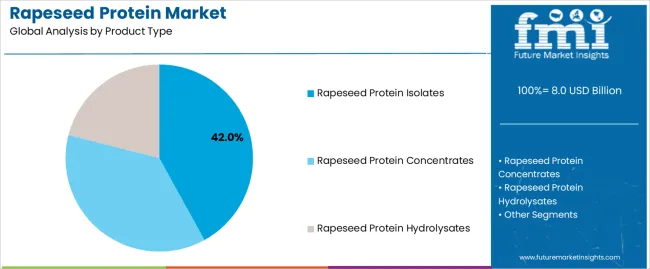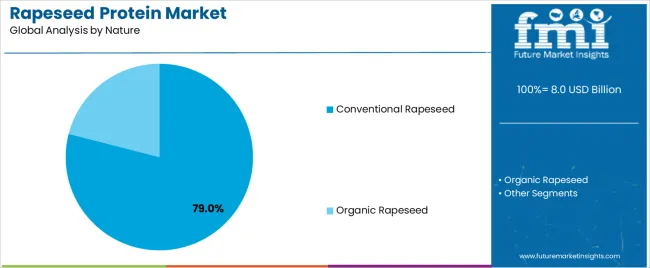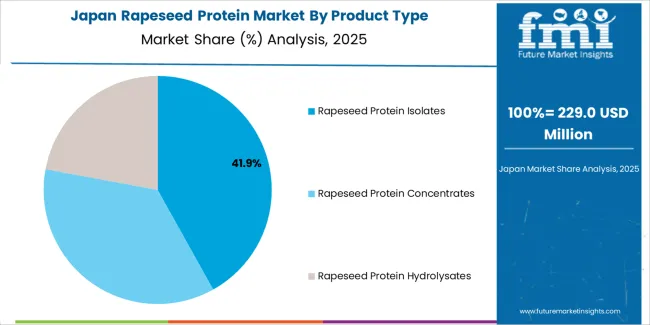The rapeseed protein market is witnessing growing momentum as the global demand for plant-based protein sources continues to expand across food, beverage, and nutraceutical industries. Industry reports and product innovation announcements have underscored rapeseed protein’s emerging role as a functional and sustainable alternative to soy and pea proteins. Nutritional research has highlighted rapeseed protein’s favorable amino acid profile, digestibility, and allergen-friendly composition, supporting its rising inclusion in meat substitutes, dairy alternatives, and sports nutrition formulations.
Additionally, advances in protein extraction technologies have improved purity and functionality, opening new application possibilities in clean-label product development. Consumer demand for environmentally responsible ingredients has aligned with rapeseed’s low input cultivation footprint, enhancing its appeal among food manufacturers. Strategic partnerships between ingredient suppliers and food companies have also accelerated commercial adoption in high-growth segments.
Looking ahead, market expansion is expected to be driven by increased investments in research, diversification of applications, and greater visibility of rapeseed protein in mainstream and specialty nutrition categories.

| Metric | Value |
|---|---|
| Rapeseed Protein Market Estimated Value in (2025 E) | USD 8.0 billion |
| Rapeseed Protein Market Forecast Value in (2035 F) | USD 10.9 billion |
| Forecast CAGR (2025 to 2035) | 3.1% |
The market is segmented by Product Type, Nature, and Application and region. By Product Type, the market is divided into Rapeseed Protein Isolates, Rapeseed Protein Concentrates, and Rapeseed Protein Hydrolysates. In terms of Nature, the market is classified into Conventional Rapeseed and Organic Rapeseed. Based on Application, the market is segmented into Food And Beverages, Animal Feed, Nutritional And Dietary Supplements, Cosmetics And Personal Care Products, and Others. Regionally, the market is classified into North America, Latin America, Western Europe, Eastern Europe, Balkan & Baltic Countries, Russia & Belarus, Central Asia, East Asia, South Asia & Pacific, and the Middle East & Africa.

The Rapeseed Protein Isolates segment is projected to contribute 42.0% of the rapeseed protein market revenue in 2025, reflecting its leading position among product types. Growth in this segment has been driven by the superior protein content, purity, and functional properties of isolates compared to concentrates or flours.
Food formulators have increasingly adopted rapeseed protein isolates for their emulsification, solubility, and foaming capabilities, particularly in plant-based dairy and bakery applications. Scientific studies and product trials have confirmed the nutritional value of isolates, making them suitable for fortification in high-protein beverages and nutritional supplements.
Additionally, the ability to tailor sensory properties through advanced processing techniques has supported broader market penetration of isolates in taste-sensitive consumer products. As demand rises for high-performance, allergen-free, and non-GMO plant proteins, the Rapeseed Protein Isolates segment is expected to maintain its growth trajectory and lead the market’s value-added product offerings.

The Conventional Rapeseed segment is anticipated to account for 79.0% of the rapeseed protein market revenue in 2025, underscoring its stronghold as the dominant cultivation type. This segment’s leadership has been reinforced by the extensive availability and established agricultural networks supporting conventional rapeseed farming.
Farmers and ingredient processors have favored conventional variants for their higher yield, pest resistance, and cost efficiency compared to organic alternatives. Procurement data from ingredient manufacturers have indicated reliable supply chains and scalability, which are essential for industrial-scale protein extraction.
Additionally, regulatory approvals and market access for conventionally grown crops have streamlined their use in mainstream food and beverage production. While demand for organic and clean-label ingredients is growing, the price competitiveness and accessibility of Conventional Rapeseed are expected to sustain its market dominance in the short to mid-term, especially in large-volume food processing applications.

The Food and Beverages segment is projected to hold 58.0% of the rapeseed protein market revenue in 2025, making it the primary application driver. Market growth in this segment has been supported by the increasing incorporation of rapeseed protein into dairy substitutes, meat analogues, baked goods, and nutritional beverages.
Formulators have utilized rapeseed protein’s balanced amino acid composition and favorable functional traits to enhance texture, stability, and nutritional content in plant-based recipes. Consumer preference for sustainable and allergen-conscious protein sources has encouraged food brands to explore rapeseed protein as a differentiator.
Ingredient suppliers have launched specialized rapeseed protein variants tailored for food-grade applications, emphasizing clean-label appeal and functional versatility. Additionally, the rapid growth of vegan and flexitarian diets across global markets has increased demand for novel plant proteins in food innovation. With continuous product development and market entry of new rapeseed protein-based foods, the Food and Beverages segment is expected to remain at the forefront of application-led growth.
Diverse Product Applications Boosting Growth
The application area of rapeseed protein is growing significantly, ranging from animal feeds, meat analogues, bakery products, functional foods, and personal care items. This versatility of canola protein is set to play a key role in providing impetus for sales growth through 2035.
Being an excellent source of essential amino acids, minerals, and vitamins, canola protein is gaining popularity among health-conscious consumers. Surging demand for healthy and nutritious food choices globally will likely impact sales.
Growing Demand for Plant-based Proteins Influencing Sales
Rising demand for plant-based products and increasing vegan population are key market trends in rapeseed protein sector. Consumers in the contemporary world are seeking plant-based proteins due to ethical, health, and environmental reasons. This is acting as a catalyst triggering product sales, and the trend will likely persist through 2035.
Canola protein is becoming an attractive choice due to high amino acid content and allergy-free nature. Growing popularity of this plant-based protein across the world is anticipated to facilitate sector growth.
There is also a surge in vegan and vegetarian populations globally, leading to high demand for plant-based food products. Courtesy of this, rapeseed/canola protein manufacturers will find immense opportunities in this industry.
Limited Awareness and Availability of Alternative Proteins Limiting Growth
The rapeseed protein industry forecast looks optimistic as demand for plant-based proteins continues to surge. However, the sector is facing certain limitations that might limit its growth.
Several manufacturers are widely using alternative proteins like pea protein and soy protein due to their benefits. This is expected to have a negative impact on the rapeseed protein market growth.
Consumers in various regions are also not familiar with canola protein as it is a relatively new player to established ones like pea and soy proteins. This is also acting as a barrier to the industry's growth.
Global rapeseed protein sales recorded a CAGR of 4.9% between 2020 and 2025. This steady growth was fueled by increased demand for plant-based products globally.
In recent years, the plant-based food industry has witnessed strong growth. People have shown an inclination toward consuming plant-based products, which has led to increased demand for plant-based proteins like canola protein.
High adoption of canola protein in nutritional and dietary supplements also provided impetus for sales growth. Similarly, cost-effectiveness and high nutritional profile of this protein made it popular in animal feed sector.
Looking ahead, the global rapeseed protein industry is set to register a CAGR of 3.1%, indicating a reduction of 1.8% CAGR compared to the historical growth rate. This decreased growth rate can be due to high adoption of alternatives like pea protein and mycoprotein.
Prominent growth factors influencing the rapeseed protein market include growing health and wellness concerns and surging interest in plant-based proteins. Increasing awareness about the potential health, nutritional, and environmental benefits of canola protein will also benefit the sector.
Canola protein has become a sustainable and nutritious alternative to traditional protein sources. High protein content, better digestibility, and potential benefits of rapeseed oil are fueling its demand globally.
Another key factor propelling rapeseed protein demand is the ongoing food fortification trend. Leading food and beverage manufacturers are incorporating canola protein in their products to enhance nutritional profile and woo health-conscious consumers.
Tier 1 companies comprise industry leaders with huge revenue, capturing a significant industry share of the rapeseed protein market. These leaders are focused on increasing production capacities. They offer different protein ingredients with enhanced functionalities.
These leading companies are working on utilizing advanced extraction methods to create high quality rapeseed-based items and enhance the taste and functionality of their products. Prominent companies within Tier 1 include DSM, TEUTEXX, and Europa Crown Ltd.
Tier 2 companies include mid-size players having presence in specific regions and highly influencing the local market. These are characterized by a strong presence overseas and strong industry knowledge.
They are striving to educate consumers about the nutritional value and other benefits of canola protein. Tier 2 companies also invest in research and development to overcome challenges like bitterness. One prominent company in tier 2 is GP Feeds Ltd.
The below section depicts rapeseed protein market forecast across various countries. South Korea and Japan are predicted to experience significant growth, exhibiting CAGRs of 5.2% and 4.8%, respectively, through 2035.
Market opportunities for organic and non-GMO rapeseed protein products exist in nations like the United States, Germany, and the United Kingdom. Similarly, integration of rapeseed protein in meat analogues and alternative protein products will likely boost growth in mature pockets.
Growing awareness of the nutritional benefits of canola protein for vegan and vegetarian diets is anticipated to fuel growth in nations like India, China, and Korea. The impact of dietary trends on the rapeseed protein market in these nations is also notable.
| Countries | CAGR 2025 to 2035 |
|---|---|
| United States | 3.4% |
| China | 3.8% |
| United Kingdom | 4.3% |
| Japan | 4.8% |
| South Korea | 5.2% |
The United States is forecast to register steady growth totaling USD 10.9 billion by 2035. Demand for canola seed protein in the nation will likely increase at a CAGR of around 3.4% during the assessment period.
Multiple factors are expected to propel growth of the canola protein market in the United States through 2035. One such factor is the ongoing innovation boom in the nation’s thriving food sector.
In the United States, food industry is witnessing an innovation boom, with leading manufacturers increasingly seeking alternative proteins. This will likely play a key role in propelling demand for rapeseed protein in the nation over the next ten years.
Consumers in the United States are also seeking food products with natural and plant-based ingredients. This is also prompting food manufacturing companies to utilize ingredients like canola protein in their products.
The United Kingdom's rapeseed protein industry is expected to experience a CAGR of 4.3% during the forecast period. The market value is projected to total USD 428.2 million by 2035. The growing popularity of canola protein among consumers, due to its multiple health and nutritional benefits, is increasing its sales in the UK.
Rapeseed/canola protein competes with other plant proteins based on its low allergenicity and complete protein content. Besides this, consumers are becoming aware of its health benefits like cholesterol-lowering properties, which is making it an ideal choice for health-conscious consumers in the United Kingdom.

Japan is anticipated to experience a steady CAGR of 4.8% during the assessment period. The nation is projected to offer lucrative opportunities to canola protein manufacturers. The demand for canola protein is especially high among the expanding geriatric population and increasing demand for functional foods and beverages.
The health and fitness movement in Japan is gaining immense traction among the population. This is prompting consumers to seek foods and beverages that provide additional health benefits. Thus, it is expected to fuel sales of rapeseed protein over the forecast period.
Canola protein is also extensively used in functional foods and beverages to increase their protein content. As consumer interest in functional foods keeps growing in Japan, the target industry is set to witness a steady growth trajectory through 2035.
The section below sheds some light on key segments. Detailed rapeseed protein market segmentation can help companies invest in demanding products to boost revenues and stay ahead.
| Segment | Isolates (Product Type) |
|---|---|
| Value Share (2025) | 42% |
The isolates segment leads the global market, accounting for a value share of 42% in 2025. Further, demand for canola protein isolate is anticipated to surge at 2.8% CAGR during the assessment period.
High protein content of canola protein isolates is a key factor behind their growing popularity and adoption across several industries, including food and beverages. Isolates also exhibit excellent functional properties, including emulsification and solubility, leading to increased usage.
Technological advancements in rapeseed protein extraction and processing are helping manufacturers to improve quality and functionality of canola protein isolates as well as reduce costs. This will further boost segment growth during the assessment period.
| Segment | Conventional (Nature) |
|---|---|
| Value Share (2025) | 62% |
When it comes to nature, the conventional rapeseed segment dominates the global canola protein industry, accounting for a value share of 62% in 2025. For the projection period, a CAGR of 2.6% has been assigned for the same segment.
One key factor behind the segment’s dominance is the cost-effectiveness of the product. Conventional rapeseed is cheaper than other varieties. Manufacturers often find conventional rapeseed protein attractive due to its affordable nature.
High adoption of conventional canola protein in a variety of food products due to cost-effectiveness and functional properties is expected to boost sales. Subsequently, well established farming practices and growing applications of conventional canola protein in animal feed sector will likely boost segment growth through 2035.

Key players in the rapeseed protein market are focusing on creating new protein products like hydrolysates, concentrates, and isolates for different uses in industries. Large investments are being made by companies like DSM in research and development to improve the taste, texture, and functionality of oilseed rape protein to make it more appealing to consumers.
Players are also partnering with end users like food manufacturers and cosmetic brands to boost sales growth and revenue. Similarly, strategies like partnerships, acquisitions, distribution agreements, new facility expansions, and mergers are making the competitive landscape of the rapeseed protein industry fiercer.
Companies are also striving to educate consumers about the potential health and environmental benefits of canola protein. This is expected to be instrumental in expanding their customer base in the upcoming years.
Industry Updates
Based on product type, the industry is segmented into isolates, concentrates, and hydrolysates.
When it comes to nature, the sector is categorized into conventional rapeseed and organic rapeseed.
In terms of applications, the sector is segmented into food and beverages, animal feed, nutritional and dietary supplements, cosmetics and personal care products, and others. The food and beverages segment is further divided into bakery, confectionery products, meat, dairy, and others.
Industry analysis has been carried out in key countries of North America, Latin America, Europe, East Asia, South Asia, Oceania, and the Middle East and Africa.
The global rapeseed protein market is estimated to be valued at USD 8.0 billion in 2025.
The market size for the rapeseed protein market is projected to reach USD 10.9 billion by 2035.
The rapeseed protein market is expected to grow at a 3.1% CAGR between 2025 and 2035.
The key product types in rapeseed protein market are rapeseed protein isolates, rapeseed protein concentrates and rapeseed protein hydrolysates.
In terms of nature, conventional rapeseed segment to command 79.0% share in the rapeseed protein market in 2025.






Full Research Suite comprises of:
Market outlook & trends analysis
Interviews & case studies
Strategic recommendations
Vendor profiles & capabilities analysis
5-year forecasts
8 regions and 60+ country-level data splits
Market segment data splits
12 months of continuous data updates
DELIVERED AS:
PDF EXCEL ONLINE
Assessing Rapeseed Protein Market Share & Industry Trends
Rapeseed Oil Market Size and Share Forecast Outlook 2025 to 2035
Rapeseed Meal Market Analysis by Type, Application, Nature, and Region Through 2035
Grapeseed Oil Market Size and Share Forecast Outlook 2025 to 2035
Protein-Coating Line Market Forecast Outlook 2025 to 2035
Protein Labelling Market Size and Share Forecast Outlook 2025 to 2035
Protein Puddings Market Size and Share Forecast Outlook 2025 to 2035
Protein/Antibody Engineering Market Size and Share Forecast Outlook 2025 to 2035
Protein Expression Market Size and Share Forecast Outlook 2025 to 2035
Protein Purification Resin Market Size and Share Forecast Outlook 2025 to 2035
Protein Hydrolysate For Animal Feed Application Market Size and Share Forecast Outlook 2025 to 2035
Protein Crisps Market Outlook - Growth, Demand & Forecast 2025 to 2035
Protein Hydrolysate Market Size and Share Forecast Outlook 2025 to 2035
Protein Supplement Market - Size, Share, and Forecast 2025 to 2035
Protein Powder Market Analysis - Size, Share, and Forecast Outlook 2025 to 2035
Protein Purification and Isolation Market Insights – Size, Share & Forecast 2025 to 2035
Protein Ingredients Market Analysis - Size, Share, and Forecast 2025 to 2035
Protein A Resins Market Trends, Demand & Forecast 2025 to 2035
Proteinase K Market Growth - Trends & Forecast 2025 to 2035
Proteinuria Treatment Market Insights – Demand & Forecast 2025 to 2035

Thank you!
You will receive an email from our Business Development Manager. Please be sure to check your SPAM/JUNK folder too.
Chat With
MaRIA